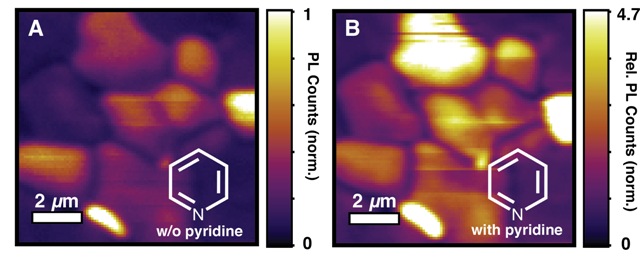May 4 2015
Researchers from the University of Washington and University of Oxford have identified inefficient regions in perovskites and have shown that those defects can be engineered to further improve solar devices.
 The quality of the perovskite materials for electronic device applications improved after chemical treatment, remediating the “dark” areas. (Credit. University of Washington)
The quality of the perovskite materials for electronic device applications improved after chemical treatment, remediating the “dark” areas. (Credit. University of Washington)
Perovskites, which are thought to have an invariable composition, are the key interest of solar energy research. When compared to silicon-based semiconductors, these materials convert solar energy into electricity more efficiently and economically.
These superefficient materials have increasingly gained the interest of the scientific community in recent times owing to their ability to be processed inexpensively and their widespread applications, from solar cells to light-emitting diodes (LEDs) used in computer monitors and phones.
“Perovskites are the fastest-growing class of photovoltaic material over the past four years,” said lead author Dane deQuilettes, a UW doctoral student working with David Ginger, professor of chemistry and associate director of the UW Clean Energy Institute.
“In that short amount of time, the ability of these materials to convert sunlight directly into electricity is approaching that of today’s silicon-based solar cells, rivaling technology that took 50 years to develop. But we also suspect there is room for improvement,” deQuilettes said.
Using high-powered imaging techniques, the researchers identified the flaws in the perovskite films that restrict the charge movement, and, in turn, the efficiency of the devices. The efficiency of perovskite solar cells is currently around 20%, whereas the efficiency of silicon-based solar cells is roughly 25%.
To investigate the semiconductor technology, the team, in association with the Clean Energy Institute, employed the confocal optical microscopy technique that is widely used in biology. The researchers identified “dark” or poorly performing regions at the crystal intersections of the perovskite material by correlating the fluorescent images with electron microscopy images. They also observed that a simple chemical treatment could “turn on” some of these inefficient regions.
Ginger, the Alvin L. and Verla R. Kwiram Endowed Professor of Chemistry and Washington Research Foundation Distinguished Scholar, stated that the images provided some exciting results, which could improve the efficiency, stability and uniformity of the materials.
“Surprisingly, this result shows that even what are being called good, or highly-efficient perovskite films today still are ‘bad’ compared to what they could be. This provides a clear target for future researchers seeking to improve and grow the materials,” Ginger said.
Ginger went on to say that the UW team's imaging technique can easily locate unexposed defects in perovskite materials and the corresponding regions where the composition can be chemically modified for performance improvement.
According to deQuilettes, a Clean Energy Institute graduate fellow who led the project, a number of laboratories worldwide are currently focusing on the perovskite's semiconducting properties. However, more work needs to be carried out to develop an understanding of how to consistently produce a stable material with uniform brightness and the ability to withstand moisture without deteriorating.
The UW research provides different ways to strategically determine the methods of improving the material’s performance and expanding the material’s applications to high performance LEDs, including lasers.
“There are so many of us focusing on perovskites, so hopefully this technique will offer some new direction and steer us toward the places we can look to optimize their energy-capturing and emitting potential,” deQuilettes said.
Samuel D. Stranks, Giles E. Eperon and Henry J. Snaith at Oxford and Sarah M. Vorpahl, Hirokazu Nagaoka and Mark E. Ziffer of the UW are the co-authors of the study.
The research was funded by the state of Washington through the UW Clean Energy Institute.
The study results have been published in the Science journal.